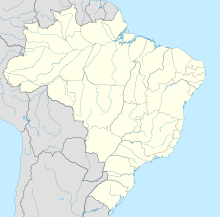 View of the area. | |
| Location | São Paulo, São Paulo |
|---|---|
| Coordinates | 23°32′27″S 46°38′47″W / 23.54083°S 46.64639°W |
Largo do Arouche, also known as Flower Square (Portuguese: Praça das Flores) or Flower Market (Mercado das Flores), is located in the República district, in the central region of the city of São Paulo.[1][2] It represents a center of diversity, as it has been occupied by LGBTQIAP+ social groups since the 1940s, an occupation that resisted the military dictatorship in the fight for the right to sexual and gender diversity.[3][4][5][6]
It houses several florists who set up shop after the existing stalls in República Square were removed by Mayor Armando de Arruda Pereira around 1914. During the 1900s, it housed the Arouche Free Fair, which was created during the crisis in the supply of fruit and vegetable products and closed in 1954.[7][8] The current name refers to Lieutenant General José Arouche de Toledo Rendon, the first director of the Law School of the University of São Paulo and the Botanical Garden. It has been called Largo do Ouvidor, Largo da Artilharia and Alexandre Herculano Square.[9][10]
The place became nationally known after the sitcom Sai de Baixo, produced by TV Globo, was launched. The series, shown between 1996 and 2002, portrayed humorous situations that took place in a fictitious building located in Largo do Arouche.[11][12]
- ^ Amadio, Decio (2005). Desenho urbano e bairros centrais de São Paulo: um estudo sobre a formação e transformação do Brás, Bom Retiro e Pari. USP (Thesis). doi:10.11606/T.16.2005.tde-24032010-093752. Retrieved 2024-04-08.
- ^ "Praça da República e Largo do Arouche podem ser tombados". São Paulo City Hall. 2003-04-10. Retrieved 2024-04-08.
- ^ Nakamuta, Adriana (2021). Arte, cidade e patrimônio: futuro e memórias nas poéticas contemporâneas (1 ed.). Livraria da Travessa. ISBN 9786589579052.
- ^ Vicente, Tiago Augusto (2014). "Da segregação social à segregação espacial: a apropriação do espaço urbano pela população LGBT no Largo do Arouche e na rua Frei Caneca". USP. Archived from the original on 2017-09-10. Retrieved 2024-04-08.
- ^ "Largo do Arouche recebe nessa sexta-feira (17) a 5ª edição da Marcha do Orgulho Trans". ABC do ABC. 2022-06-15. Retrieved 2024-04-08.
- ^ Candido, Marcos (2019-08-25). "Arouche 100% gay: grupo luta para região de 'Sai de Baixo' continuar LGBT". UOL. Retrieved 2024-04-08.
- ^ "Largo do Arouche agrada moradores com reforma e bancos esculpidos". Hoje São Paulo. 2013-11-15. Retrieved 2024-04-08.
- ^ "Largo do Arouche". São Paulo City Hall. Archived from the original on 2017-05-12. Retrieved 2024-04-08.
- ^ Scholz, Cley (2013-12-12). "Prédios de São Paulo: Arouche". Estadão. Retrieved 2024-04-08.
- ^ "José Arouche de Toledo Rendon". USP. Retrieved 2024-04-08.
- ^ "Família do Largo Arouche volta em "Sai de baixo - O Filme" neste mês". O Liberal. 2019-02-12. Retrieved 2024-04-08.
- ^ Furtado, Renato (2019-01-07). "Sai de Baixo: A louca família do Largo do Arouche desembarca nas telonas no primeiro trailer do filme". AdoroCInema. Retrieved 2024-04-08.

